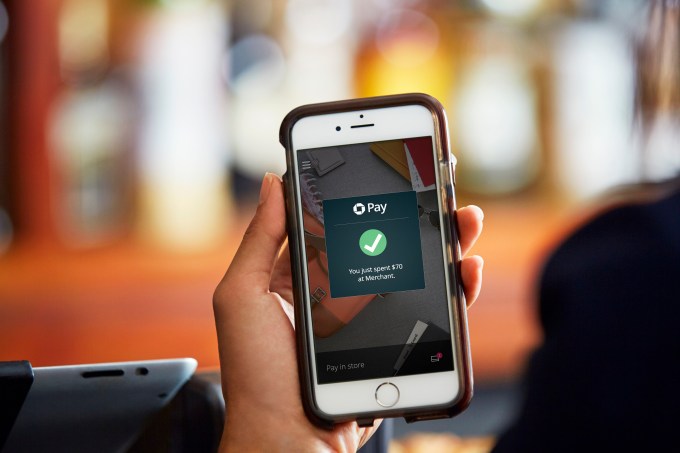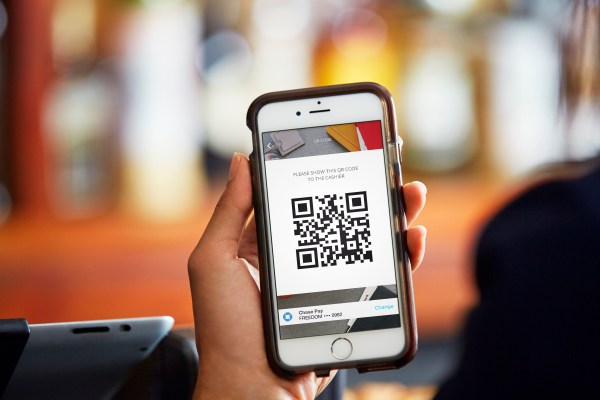Big retail is looking to carve out a piece of the mobile payments pie, where competitors like Apple Pay, Android Pay, Samsung Pay, PayPal, Square and others now battle. This week, the retailer-backed mobile payments consortium MCX announced it would be the premier partner for the newly unveiled mobile payments platform Chase Pay from JP Morgan Chase.
Described as a “closed loop network,” Chase Pay will allow Chase’s 94 million credit, debit and pre-paid card customers the ability to make in-store, in-app and online purchases, beginning in 2016.
Chase touts a number of advantages it has over some current mobile payment systems, noting that Chase consumers will be able to use the service on “virtually all” smartphones, and will be able to pay at places where other mobile payments don’t always work – like gas stations and drive-through windows, for example.
Plus, in some locations, Chase says that consumers will be able to use their smartphone to take a picture of their receipt to pay.
In addition, retailers’ loyalty programs will also be supported, meaning that customers won’t need to tote around their plastic loyalty cards or key fobs in order to earn points, use coupons, or receive discounts.
Chase brings to the table a large number of potential users, noting that one of every two U.S. households is a Chase customers. It’s also number one is total U.S. credit and debit payment volume, whith $707 billion in sales last year.
Thanks to Chase Pay’s MCX backing, the platform will be rolled out beginning in mid-2016 to merchants who represent over 100,000 retail locations across the U.S. The MCX consortium, backed by retailers like Walmart, Target, Best Buy and Shell, have stores in the big-box, convenience, pharmacy, fuel, grocery, quick- and full-service dining, specialty-retail and travel categories.

The retailer support is something that the consortium hopes will allow Chase Pay to topple Apple Pay and others’ growing traction in the payments space.
Meanwhile, rival Apple Pay has a head start. Apple CEO Tim Cook said at the beginning of the year that Apple Pay accounted for two out of every three dollars spent in “contactless payments.” But that’s still a small number. According to a survey from Verifone, cited by Reuters, mobile wallets only accounted for around 4 percent of the overall payments market for in-store retail transactions.
In other words, the retailers believe that because it’s still early days for mobile payments, they have a chance to compete with the native solutions offered by Apple and Google, as well as those from third parties, like PayPal and others.
The QR Code Problem
That being said, there’s one huge caveat with regard to Chase Pay: unlike Apple Pay and Android Pay, which are NFC-based (tap-and-pay) solutions, Chase Pay uses QR codes. That means shoppers have to show the QR code to the cashier, who then scans it.
This feature certainly sets Chase Pay apart from competitors’ offerings, but it could be challenged with regard to consumer adoption. For a number of reasons, QR code scanning has never taken off in the U.S.
In addition, while this system would have the advantage of being supported by a larger number of smartphones, it won’t be as seamless as using a tap-and-pay technology like Apple Pay. With NFC-based payments, users don’t have to launch an app – they just hold their phone near a supported terminal. But Chase Pay will require users to unlock their phone, find and launch MCX’s CurrentC app, display the QR code, and wait for it to be scanned.
![]()
Finally, as a pro-retailer solution, merchants have the advantage of a network that includes no network or processing fees and no merchant fraud liability. But they’re also getting shoppers’ data – something that today’s more privacy-minded consumers are fighting back against.
These days, Apple is positioning itself as being in favor of increased user privacy compared with its competitors, whether that’s when implementing its search service, refusing to unlock users’ phones when requested by law enforcement, and yes, when developing Apple Pay.
“We don’t think you should ever have to trade [your privacy] for a service you think is free but actually comes at a very high cost. This is especially true now that we’re storing data about our health, our finances and our homes on our devices,” Apple CEO Tim Cook said earlier this year.
At the end of the day, then, what Chase Pay is offering is a more data-demanding service that’s not as fast or as simple to use, and one that will co-exist on many terminals where NFC-based mobile payments are already supported.
Good luck, Chase Pay.
